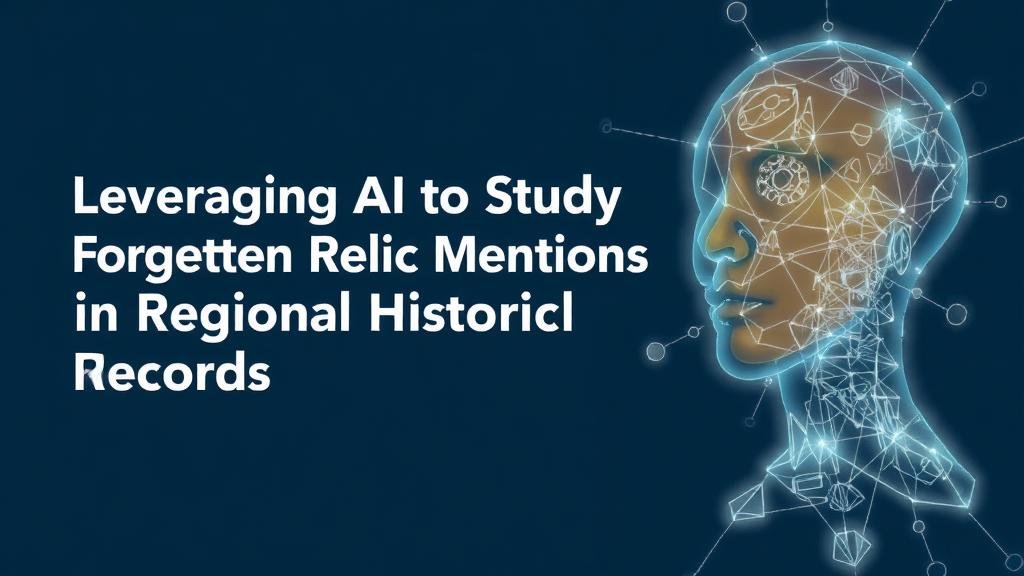Leveraging AI to Study Forgotten Relic Mentions in Regional Historical Records
Leveraging AI to Study Forgotten Relic Mentions in Regional Historical Records
This article explores the integration of artificial intelligence (AI) in the analysis of historical documents to uncover mentions of forgotten relics. The study underscores how AI can enhance our understanding of regional histories by processing vast quantities of text, recognizing patterns, and identifying significant historical artifacts that would otherwise remain lost in time.
The Importance of Historical Records
Historical records serve as a crucial repository of knowledge, documenting the socio-political, economic, and cultural narratives of both local and global significance. But, many regional documents remain underutilized, particularly those that mention relics of historical importance. e relics often tell stories about cultural practices, trade routes, and community identity. The challenge lies in efficiently analyzing extensive archives, frequently written in archaic language or dispersed across various repositories.
Challenges in Traditional Methods
Traditional methods of historical research, such as manual archival research and qualitative analysis, present numerous challenges:
- Time-consuming efforts required to sift through extensive records.
- The potential for human error in transcription and interpretation.
- Limited accessibility to physical records, especially during events like the COVID-19 pandemic.
As such, many potentially significant relic mentions have gone unnoticed, leading to gaps in historical understanding.
AI and its Applications in Historical Research
AI technologies, particularly natural language processing (NLP) and machine learning (ML), provide innovative solutions to these challenges. By employing algorithms designed to recognize and interpret text, researchers can automate the extraction of relevant data from historical documents.
For example, the Text Analysis Portal for Research (TAPoR) has facilitated the processing of textual data through AI, allowing historians to analyze patterns within literature and documents rapidly. A case study on the integration of AI in historical research revealed that using ML models could identify previously overlooked terms related to relics, significantly expanding the corpus of accessible information.
Case Studies of AI Integration
Numerous projects have successfully utilized AI to identify and analyze forgotten relics within historical records:
- The Old Bailey Proceedings Online (OBPO): This digital archive indexed criminal cases from 1674 to 1913. By implementing NLP techniques, researchers accessed discussions about cultural artifacts referenced in cases involving theft or ownership disputes.
- Machine Learning Models Applied in Archaeology: Projects such as Digital Karnak have utilized AI to analyze ancient Egyptian texts. This led to the discovery of relic mentions that were not apparent during manual analyses, reviving interest in certain archaeological sites.
Benefits of AI in Historical Research
The benefits of leveraging AI in historical research extend beyond just identifying forgotten relic mentions:
- Increased Efficiency: AI algorithms can process thousands of documents in a fraction of the time required for manual research.
- Enhanced Accuracy: With significant data training, AI models can outperform individual human efforts, minimizing errors in data extraction and categorization.
- Broader Access to Information: Digitized databases linked with AI tools can provide researchers worldwide with access to data that would otherwise be regionally limited.
Ethical Considerations
While the implementation of AI in historical research holds considerable promise, certain ethical considerations must also be addressed:
- Loss of nuanced interpretation may occur when relying solely on automated systems.
- Data privacy issues regarding the digitization of personal historical records must be considered, ensuring consent and protection of sensitive information.
Conclusion and Actionable Takeaways
The marriage of AI and historical research provides a robust framework for uncovering forgotten relic mentions within regional historical records. Utilizing AI not only saves time but also enhances the breadth and depth of historical studies. Researchers are encouraged to:
- Adopt AI-based tools in their archival research processes to expand the scope of their analyses.
- Engage in interdisciplinary projects that combine historical expertise with technological innovations.
- Maintain an ethical stance by considering the nuances of historical data and ensuring the protection of sensitive information.
In summary, the integration of AI in the study of forgotten relics is not merely a technological advancement; it is a necessary evolution in understanding and interpreting our shared history.


